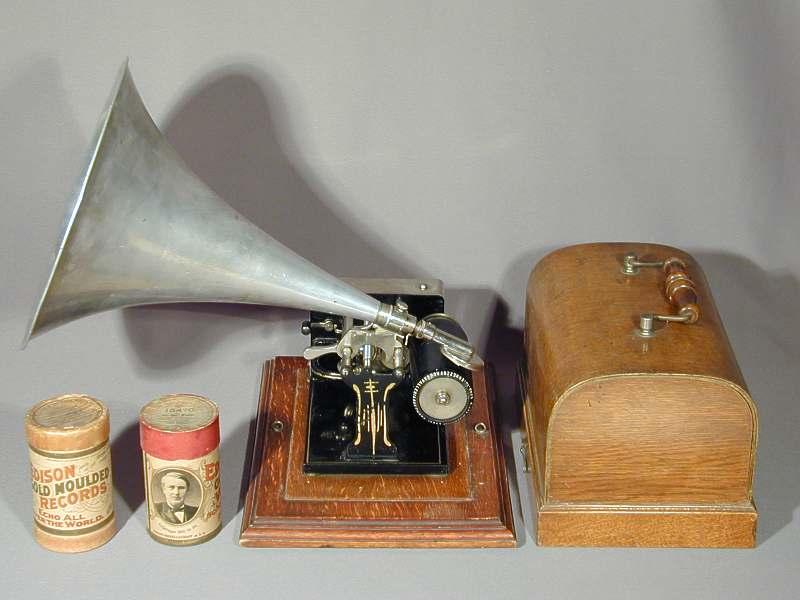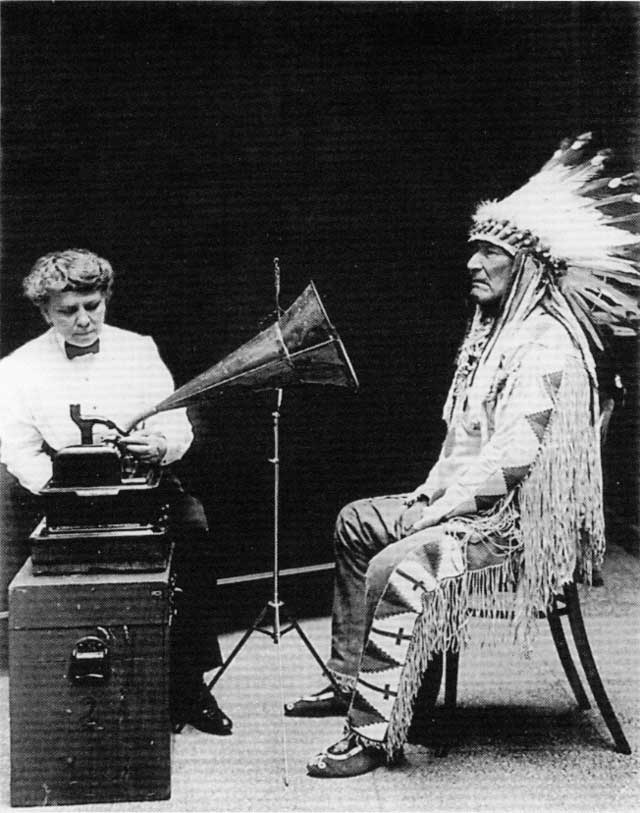Neither God nor Devil: The long dance between Technology and Music | reviews, news & interviews
Neither God nor Devil: The long dance between Technology and Music
Neither God nor Devil: The long dance between Technology and Music
From Edison's phonograph to iTunes and Spotify, technology has always shaped not just how we listen, but what we listen to

David Byrne's new book How Music Works has once again brought to the fore the ever thorny debate about the relationship between technology and music. The dance between the two is being conducted at an ever more frenetic pace, and seems likely to continue to do so throughout 2013.
In some countries ringtones now make up a reported 20 per cent of record companies profits - will labels be less inclined to sign or promote music that doesn’t boast a suitable catchy few seconds? ITunes and iPads clearly favour tracks over albums, while it’s become increasingly an advantage for artists to produce music that works with video games. On the other hand, Spotify claim that subscriptions for streaming means people are actually more likely to hear albums in their entirety.
In 1904 composer John Philip Souza predicted the imminent death of live music
The increasing temperature around the subject has resulted in several books. Mark Katz’s Capturing Sound: How Technology Has Changed Music is a more focused book than Byrne's and begins with Edison’s wax cylinder, invented in the 1870s. Originally Edison believed the major uses for it would be for business purposes and for preserving the voices of the deceased. By 1900, it was being marketed as a purely musical device. The notion that you could listen to music on your own was a novel one – usually people listened to it in groups, even applauding at the end.
Katz, like Byrne, argues convincingly that, from that point, technology has been instrumental in dictating the types of music and musicians that have become popular. The first real star of the new medium was Enrico Caruso, the operatic tenor, whose particular tone cut through the haze of the early technology as, a little later, did Louis Armstrong’s trumpet. Pianos and violins did not fare so well. When Edison attempted to record Johannes Brahms in 1889, performing his first Hungarian Dance, the result, according to critic Alex Ross sounded “as if the Master were coming to us from a spaceship disintegrating near Pluto”. The most famous violinist of the 1920s, Fritz Kreisler developed a trademark, much copied vibrato tone, which worked with phonographs.
 The development of good microphones and magnetic tape by German engineers in the Second World War had a profound effect on popular music. The intimate crooning of Bing Crosby and Frank Sinatra wouldn’t have been possible without it. In India, a country with millions of dirt cheap transistors, the style of Bollywood music was all swooning strings and high-pitched singers like Asha Bhosle (whose first recording was made in 1943, aged 10, and was still in stunning form in London last year). Katz calls this feedback loop with technology “the phonograph effect”.
The development of good microphones and magnetic tape by German engineers in the Second World War had a profound effect on popular music. The intimate crooning of Bing Crosby and Frank Sinatra wouldn’t have been possible without it. In India, a country with millions of dirt cheap transistors, the style of Bollywood music was all swooning strings and high-pitched singers like Asha Bhosle (whose first recording was made in 1943, aged 10, and was still in stunning form in London last year). Katz calls this feedback loop with technology “the phonograph effect”.
For all doom mongers, it’s instructive to note that from the earliest days of recording there were dire predictions about the effect of technology. In 1904 composer John Philip Souza predicted the imminent death of live music, as did piano genius Glenn Gould in an essay in 1966. They could still be right, although attendances at concerts seem to be holding up. And there is surely something miraculous about some of the new technology, even if we become rapidly blasé about it. How amazing it would be for someone from the 19th century to think that with a little metal and plastic box in my hand I can talk to someone in New York, or Tibet. Most of us are impressed by the sheer aesthetic pleasure of the shiny iPhone or Galaxy.
But let’s not pretend technology doesn’t have a profound impact. Composers like Bartok and Kodaly in the early 1900s used the phonograph to record the dying folk genres of their time. And what was causing the decimation of traditional folk music? The phonograph, more than anything.
It behoves critics, musicians and audiences to be aware of the impact of technology and if necessary counteract the more detrimental effects of it. In 2013, let’s have more recordings of elderly folk-singers in remote parts of the world. If the iPad generation are stuck in an autistic musical bubble, lets encourage grand, communal music rituals. If ringtones give an advantage to music that can be condensed to a few, melodic seconds, let us promote five hour epics. The epigraph to Katz’s book quotes music critic Hans Stukenschmidt from 1926: “The machine is neither a god nor a devil”. Better Heaven or Hell, though, to a bland musical Purgatory.
Explore topics
Share this article
The future of Arts Journalism
You can stop theartsdesk.com closing!
We urgently need financing to survive. Our fundraising drive has thus far raised £49,000 but we need to reach £100,000 or we will be forced to close. Please contribute here: https://gofund.me/c3f6033d
And if you can forward this information to anyone who might assist, we’d be grateful.

Subscribe to theartsdesk.com
Thank you for continuing to read our work on theartsdesk.com. For unlimited access to every article in its entirety, including our archive of more than 15,000 pieces, we're asking for £5 per month or £40 per year. We feel it's a very good deal, and hope you do too.
To take a subscription now simply click here.
And if you're looking for that extra gift for a friend or family member, why not treat them to a theartsdesk.com gift subscription?
more New music
 Heartbreak and soaring beauty on Chrissie Hynde & Pals' Duets Special
The great Pretender at her most romantic and on the form of her life
Heartbreak and soaring beauty on Chrissie Hynde & Pals' Duets Special
The great Pretender at her most romantic and on the form of her life
 The Last Dinner Party's 'From the Pyre' is as enjoyable as it is over-the-top
Musically sophisticated five-piece ramp up the excesses but remain contagiously pop
The Last Dinner Party's 'From the Pyre' is as enjoyable as it is over-the-top
Musically sophisticated five-piece ramp up the excesses but remain contagiously pop
 Moroccan Gnawa comes to Manhattan with 'Saha Gnawa'
Trance and tradition meet Afrofuturism in Manhattan
Moroccan Gnawa comes to Manhattan with 'Saha Gnawa'
Trance and tradition meet Afrofuturism in Manhattan
 Soulwax’s 'All Systems Are Lying' lays down some tasty yet gritty electro-pop
Belgian dancefloor veterans return to the fray with a dark, pop-orientated sound
Soulwax’s 'All Systems Are Lying' lays down some tasty yet gritty electro-pop
Belgian dancefloor veterans return to the fray with a dark, pop-orientated sound
 Music Reissues Weekly: Marc and the Mambas - Three Black Nights Of Little Black Bites
When Marc Almond took time out from Soft Cell
Music Reissues Weekly: Marc and the Mambas - Three Black Nights Of Little Black Bites
When Marc Almond took time out from Soft Cell
 Album: Mobb Deep - Infinite
A solid tribute to a legendary history
Album: Mobb Deep - Infinite
A solid tribute to a legendary history
 Album: Boz Scaggs - Detour
Smooth and soulful standards from an old pro
Album: Boz Scaggs - Detour
Smooth and soulful standards from an old pro
 Emily A. Sprague realises a Japanese dream on 'Cloud Time'
A set of live improvisations that drift in and out of real beauty
Emily A. Sprague realises a Japanese dream on 'Cloud Time'
A set of live improvisations that drift in and out of real beauty
 Trio Da Kali, Milton Court review - Mali masters make the ancient new
Three supreme musicians from Bamako in transcendent mood
Trio Da Kali, Milton Court review - Mali masters make the ancient new
Three supreme musicians from Bamako in transcendent mood
 Hollie Cook's 'Shy Girl' isn't heavyweight but has a summery reggae lilt
Tropical-tinted downtempo pop that's likeable if uneventful
Hollie Cook's 'Shy Girl' isn't heavyweight but has a summery reggae lilt
Tropical-tinted downtempo pop that's likeable if uneventful
 Pop Will Eat Itself's 'Delete Everything' is noisy but patchy
Despite unlovely production, the Eighties/Nineties unit retain rowdy ebullience
Pop Will Eat Itself's 'Delete Everything' is noisy but patchy
Despite unlovely production, the Eighties/Nineties unit retain rowdy ebullience

Add comment